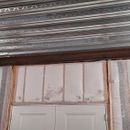Foamboard and WRB for Unconditioned Enclosure
Cold edge of Zone 4. See picture of 600 sq ft unconditioned walk-out storage space/proposed art studio (no further finishing) under suspended garage. Stays cool enough in summer with portable dehumidifier connected to floor drain. For most of winter, with indoor temps usually 40-50F, a space heater should be sufficient when using as art studio. During severe, sub-zero cold period last winter, did drop to around freezing inside, but a rare occurrence.
Walls are 12 ft high, about 50-50 concrete-wood framing. You can see R-26 blown-in walls. I’ve read here that fluff need to be closed in to be effective.
While I would like to put up foamboard, the fire-rated stuff is very expensive and usually special order. Would a vapor barrier, such as Tyvek work? I see Tyvek is Class A fire rated, which I think means it’s as good as you can get for a wallcovering. They make Tyvek FireCurb in Europe. It’s self-extinguishing with other fire features.
Also, notice the bare steel I-beams at top of walls. No insulation at all. I’m thinking I should wedge some foamboard into the beams. Would this be best? Thanks.
GBA Detail Library
A collection of one thousand construction details organized by climate and house part










Replies
I'm giving your question a bump for experts to address. One thing I feel confident in saying is that your idea to "cut and cobble" foamboard at the top of the walls is a sound one in terms of an air-sealing strategy.
Now that the holidays are over, maybe I'll get better results. Thanks.
Bruce,
The foam needs either an ignition or a thermal barrier base din its location: https://www.greenbuildingadvisor.com/article/thermal-barriers-and-ignition-barriers-for-spray-foam.
I don't see anywhere in Tyvek's literature any testing or approval as either.
From the Tyvek FAQs. Guess I'm confused, here Tyvek seems to indicate not flame retardant but also says it has a Class A rating. Is this contradictory?
Q16: Is Tyvek® flame retardant? What is its melting point and ignition point?
A: Tyvek® should not be considered as flame retardant and its flammability is like most synthetic fibers. Tyvek® type 10 has been tested according to ASTM E84-89a with a class A rating. Type 14 Tyvek® has been tested according to 16 CFR 1610 with a class 1 rating. The melting point of Tyvek® is 135°C and the ignition point of high density polyethylene is approximately 400°C. Specific flame-retardant requirements can be met by applying a special coating to Tyvek®.
Bruce,
I would suggest contacting Dupont to clear up the confusion. However as this is a common situation, and Tyvek is never brought up as a solution, nor does Dupont advertise it as such, I think the chances aren't very good.